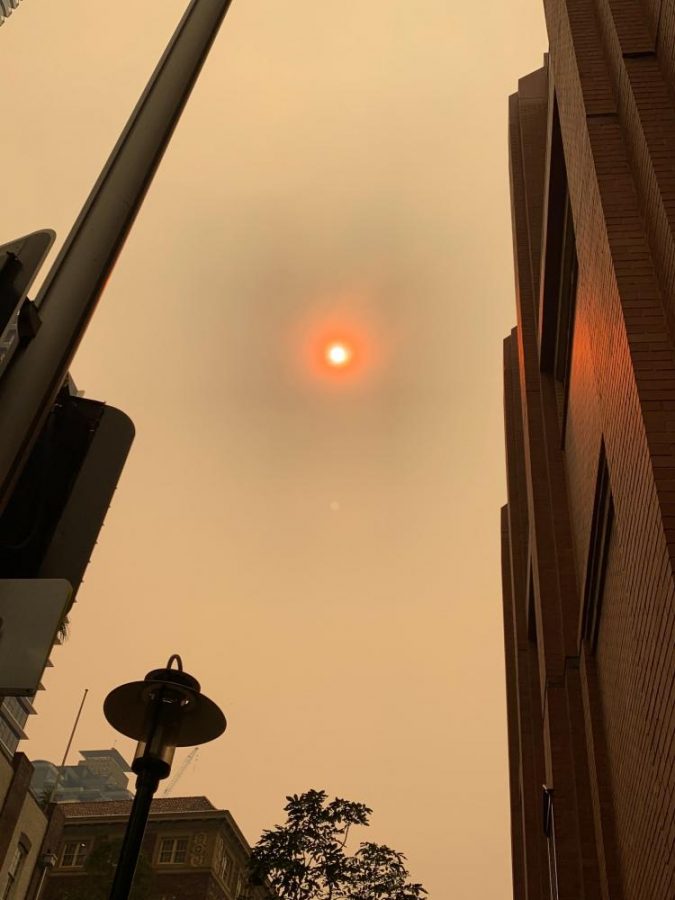As bushfires ravage Australia, NYU Sydney students and faculty recounted their experiences, describing bright red skies and the persistent smell of smoke on their commutes to class.
While the city center — where NYU Sydney campus is located — has been less affected by these fires than other areas of Australia, students complained about canceling travel plans, the dangers of smoke inhalation and having to close windows to prevent smoke from entering their dorms.
“What did impact students and faculty was that the fires were so intense and there were so many going on that there was more smoke in the city,” NYU Sydney Environmental Journalism professor Fran Molloy said. “Because it’s a warm climate and people do a lot of things outdoors, it really restricted the city people from pursuing their normal activities.”
On Dec. 9, students were excused from attending class via an email sent by Assistant Director of Student Life Marcus Neeld.
“Due to smoke and reduced air quality [New South Wales] Health is recommending residents of Sydney significantly limit all outdoor activity,” the email read. “Absences from class related to the smoke conditions will be excused for today only.”
NYU Sydney Director Mal Semple did not respond to WSN’s request for comment at the time of publication.
CAS sophomore Jason Kemp saw the aftermath of the fires last semester when he studied abroad at NYU Sydney. He described the feeling of standing in the smoke as heavy.
“It felt like something was weighing down on you if you went outside,” Kemp said. “There was about an hour if you stood outside for 10 minutes, it was like breathing in 70 cigarettes.”
Like Kemp, CAS sophomore Jessica Chapel also studied at NYU Sydney during the fires. She said that near the end of the semester, students were forced to wear face masks to avoid dangerous smoke inhalation. She added that the 35-minute walk from the dorm to the campus was often difficult.
“It was really hard to walk home because everyone was coughing,” Chapel said. “It was awful.”
Tisch senior Hannah Vickery, who also studied at NYU Sydney last fall, said that while the smoke was not always pervasive, there were days when it was clearly visible both outdoors and indoors. Some students even described smoke in the lobby of the academic building and student residence hall.
The fires led to a frequently changing sky color, students said. On certain days students said the sky was grey with smog, while on other days flames painted it hues of red and orange.
Kemp added that the push to cancel class was the strongest from faculty, many of whom live in areas more susceptible to the fires.
Molloy is one of these professors. She was personally affected by the spread of the fires when Royal National Park — located near her home in the South of Sydney — caught on fire.
“Houses districts away from me were evacuated,” Molloy said. “We were lucky that it didn’t get any worse, but everyone was very ready for things to happen.”
Bushfires are not a rare occurrence in Australia. Molloy pointed to a particularly devastating fire in 2009, which killed nearly 200 people. It is referred to as Black Saturday, as it is considered one of the deadliest fires in Australian history. Molloy added that the immense loss brought on by this blaze led Australia to reconstruct its fire safety protocol.
“Now in Australia whenever it’s a dangerous day, people around anywhere that’s fire-prone are told to get out,” Molloy said. “Our new warning regime is incredibly effective.”
Despite new safety measures, this fire season — which began in July and has yet to subside — is unprecedented in scale, causing record damage to the continent’s landscape and wildlife. The fires have claimed 28 human lives and affected more than 25 million acres of land, additionally killing an estimated one billion animals as a result.
“The rest of the world was looking at what was going on in the fire zones,” Molloy said. “Realizing how many animals were killed is just devastating.”
Molloy attributes the stretch of this particular fire season to ongoing droughts throughout the country. She emphasized her belief that Australia is a great place to study climate change and that the fires will play a substantial role in her lesson plans.
Molloy added that despite the rampant fires, she still encourages students to study at NYU Sydney.
“I feel like, here, we’re at the pointy end of climate change,” Molloy said. “We can see what’s going to happen in other countries in years to come. There are a lot of really important conversations going on, and students who come out here can be part of that.”
A version of this article appeared in the Monday, January 27th, 2020, print edition. Email Lisa Cochran at [email protected].


























































































































































